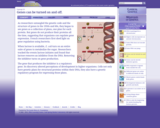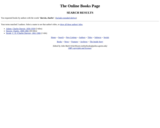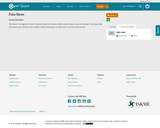
The full text of Richard Sheridan's "The Critic." Includes an introduction with information on Sheridan's life and works.
- Subject:
- Arts
- Material Type:
- Textbook
- Provider:
- Bibliomania
- Date Added:
- 10/03/2023

The full text of Richard Sheridan's "The Critic." Includes an introduction with information on Sheridan's life and works.

Two French scientists describe the research they did to figure out how bacteria turn certain genes on and off. The topic is a little involved, but the animations should help you understand the process.

Homeobox genes are important because they determine the overall body plan for most animals. This article explains the experiments that helped scientists discover these master genes. Article includes animations, pictures, video, biographical information, and quiz questions that are accessed by clicking on buttons along the bottom of the page.

This site presents the full text of Dickens' novel "David Copperfield." Content is supplemented with illustrations.

Contains plans for two lessons that teach students how to recognize an author's use of style in literature. These plans use "Their Eyes Were Watching God" by Zora Neale Hurston as an example, but the basic ideas can be adapted to other works. In addition to objectives and standards, this instructional plan contains links to sites used in the lessons as well as assessment and reflection activities. CCSS.ELA-Literacy.CCRA.L.3

The Digital Library provides links to the texts of a dozen of works by Charles Darwing including "On the Origins of Species."

The library is a mess. Someone knocked over a book cart and all the books are mixed up. Students will have to solve a series clues to create order out of chaos. Unlock the code to move on to the next clue until you find the treasure chest that holds all the answers. Use ISearch to help you find the answers to the clues. After you type in your search term, the My Library tab will give you some suggestions that will help you answer the question.

Students learn how to create stem-and-leaf diagrams and boxplots by collecting data on the surface tension of water molecules. This hands-on activity using pennies is a great way to learn how to organize data.

Downloadable booklets with basic information about the U.S. water supply, e.g., where our drinking water comes from.

This game helps students to understand the concepts of changing supply, changing demand, and equilibrium price, as the price of bags of ice changes after a hurricane has swept through a community.

Part of a larger site on Renaissance literature, this page contains quotes, Elizabeth's writings and speeches, a great biography, essays, articles, images, and more. Very helpful.

Take a tour of the 100-acre site of the Temple at Karnak on this PBS site. Click on each hyperlink or click on the temple map to see a picture and read commentary of several parts of the temple complex. QuickTime required.

This activity uses both premade activities and student created problems. It is a good way for students to learn to write equations to model real life situtations.

Contains plans for four lessons that ask students to change the action in the turning point of a tragedy in order to see the effect on the rest of the play. In addition to objectives and standards, this instructional plan contains links to sites used in the lessons as well as assessment and reflection activities.

Part of the National Air and Space Museum's online exhibition about Exploring Planets, this describes and gives visuals of telescopes, probes and fly-by aircrafts, orbiters, and landers as current methods for earth and airborne exploration of the planets. The tools and technology used to get, bring back, and analyze samples are also included.

An article about the Declaration of Independence which covers the selection of the Committee of Five, Jefferson's writing, the presentation to Congress for approval, the problems in drafting, and the final changes which were made. Included is John Adam's letter to Timothy Pickering in response to questions about the document.

This lesson is designed to help 9th grade students be able to define confirmation bias and clickbait. It will start with class discussion and then the students will find examples on their own in current news stories.

Contains plans for five lessons that teach students how to write feature news stories and the difference between feature and hard news articles. Students interview each other as prewriting for writing their own human interest stories. In addition to objectives and standards, this instructional plan contains links to sites used in the lessons as well as assessment and reflection activities.

Contains plans for three lessons about love poetry that ask students to review the genre before writing their own. In addition to objectives and standards, this instructional plan contains links to PDF handouts and sites used in the lessons as well as assessment and reflection activities. RL.11-12.7 Multi Interpretations

The lesson explains the order of operations. An explanation and examples are included.